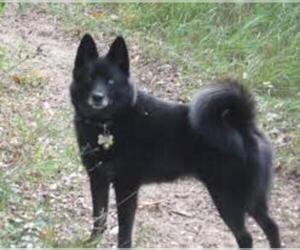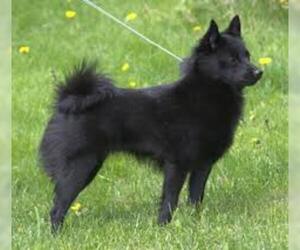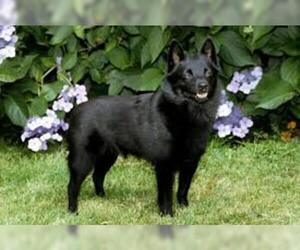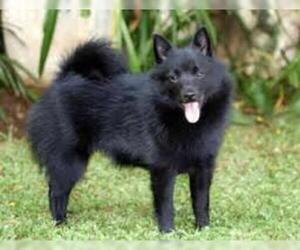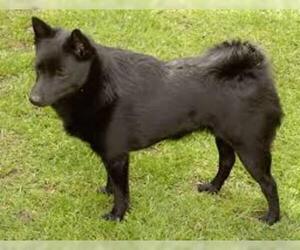
All about Schipperke dog breed
A.K.A. :Spits, Spitzke, Moorke, Little Black Devil, LBD, Belgian Barge Dog, Canal Dog, Schipp, Schippie, Black Rascal, Belgian Watchdog, Schipperke Pup, Dockyard Dog, Schipperke Scout, Velvet Shadow
Size
Grooming requirements
Exercise requirements
Good with other dogs
Watchdog ability
Energetic
Training requirements
Playful
Affectionate
Good with other pets
Good with children
Good with strangers
Winter
Summer
Healthiness
Protective
Life Span
| Pure Breeds | Member |
| Breeds A - Z | S |
| Breeds by Group | Companion Non-Sporting |
| Breeds by Trait | Good With Kids High Stamina Dog Breeds Low Shedding Smartest Dog Breeds |
| Overview: | The Schipperke, a lively and diminutive breed, originated in Belgium as a rat-catching barge dog, a heritage reflected in its name, meaning "little captain" or "little skipper." Physically, they are easily recognized by their compact, sturdy build, fox-like face, and most notably, their profuse, dense black double coat, often appearing tailless due to traditional docking (though now often naturally bobbed or left long). Despite their small size, typically 10-16 pounds, Schipperkes possess a bold, confident, and somewhat mischievous temperament. They are highly intelligent, independent, and fiercely loyal to their families, making them excellent watchdogs with their alert nature and surprisingly deep bark. While adaptable to apartment living due to their size, they require regular exercise and mental stimulation to prevent boredom and destructive behaviors. They can thrive in families with children and other pets if properly socialized, though their independent streak may require patient training. Health-wise, they are generally robust but can be prone to specific issues like Legg-Calve-Perthes disease and epilepsy, making responsible breeding practices crucial for maintaining their well-being. |
F.A.Q.
All You Need to Know About the Schipperke Breed
The Schipperke, a charming "little black devil" from Belgium, is a small, sturdy, and active companion dog. Originating as a barge dog, this breed is characterized by its fox-like face, alert expression, and either a naturally tailless or docked appearance. Schipperkes possess a confident, curious, and often mischievous temperament; they are highly intelligent and loyal, making them excellent watchdogs. Their compact size (typically 10-16 lbs) makes them well-suited for both apartment living and homes with yards, provided they receive adequate exercise. They thrive in active families who can engage their minds with training and playtime. Grooming is relatively low-maintenance, requiring weekly brushing of their double coat, with occasional more frequent brushing during shedding seasons. While generally healthy, potential adopters should be aware of common health considerations such as Legg-Calve-Perthes disease and epilepsy. The Schipperke is a spirited, devoted companion for the right owner.The average weight for Schipperke is generally between 10-16 pounds. A healthy weight for Schipperke adults typically ranges from 10 to 16 pounds, with no significant variation in Schipperke weight between males and females. Both sexes typically fall within this Schipperke size range, making them a consistently small breed.
Curious about the Schipperke height and how tall these charming little dogs get? On average, a healthy adult Schipperke typically stands between 10 to 13 inches tall at the shoulder. This compact breed is known for its sturdy build despite its small stature.
While there isn't a significant difference in average size between male and female Schipperkes, you might find some slight variations. Individual genetics, diet, and overall health can also play a role in a dog reaching the higher or lower end of this range. So, when considering "how tall is a Schipperke," expect a delightful companion that fits perfectly into most lifestyles with their manageable dimensions!The Schipperke primarily comes in solid black, which is the only color officially recognized by major kennel clubs like the AKC for show purposes. While most Schipperkes are known for their glossy black coats, you may occasionally find rare Schipperke colors or exotic Schipperke variations such as a black coat with a small white patch on the chest, though this is not preferred for show. It's important to note that Schipperke colors like brindle, fawn, cream, white, blue, lilac, merle, or chocolate are not found in purebred Schipperkes and are not accepted by the AKC or other major kennel clubs. When considering a Schipperke, expect a classic solid black coat.
The Schipperke personality is a captivating blend of alertness, curiosity, and mischievousness, earning them the nickname "Little Black Devil." They are incredibly loyal and devoted to their families, often forming a strong bond with one primary person but showing affection to all household members. While not always overtly social with strangers, they are friendly once they've deemed someone trustworthy.Their temperament of Schipperke is characterized by a confident and independent spirit. They are highly intelligent and quick learners, but can also be stubborn, requiring consistent and positive training. Schipperkes possess a keen watchdog instinct, making them excellent, albeit vocal, protectors of their homes.Apartment living is quite suitable for a Schipperke, provided they receive adequate daily exercise and mental stimulation. They are not high-endurance dogs but enjoy short, brisk walks and playtime. Inside, they are relatively calm and enjoy cuddling with their people.Regarding children and other pets, Schipperkes generally do well with older, respectful children who understand how to interact with a dog. Early socialization is key to ensuring they are comfortable around kids. With other pets, especially cats, they can coexist peacefully if introduced properly and raised together. However, their strong prey drive can make them less reliable with very small, fast-moving animals. They can be dominant with other dogs, particularly those of the same sex, so careful introductions are recommended.
The Schipperke temperament is often described as lively, curious, and devoted. They are loyal companion dogs who form strong bonds with their families. While generally friendly with their own people, Schipperkes can be reserved with strangers, making them excellent little watchdogs with a tendency to bark at new arrivals. They possess a high degree of intelligence and a strong desire to be involved in all family activities.
Schipperkes are adaptable and can thrive in apartment living as long as they receive adequate daily exercise and mental stimulation. They are typically good with children who understand how to interact respectfully with dogs, though supervision is always recommended. When properly socialized from a young age, they can coexist peacefully with other pets, but their strong prey drive might make them inclined to chase smaller animals. This breed exhibits a confident and sometimes stubborn streak, requiring consistent, positive reinforcement training. They are not overly sensitive but do best with gentle handling and clear communication. Their independent nature means they enjoy exploring but are ultimately deeply affectionate and eager to please their loved ones.Schipperke Care: Essential Daily Maintenance & Health TipsSchipperke care is relatively straightforward, making them a good choice for active owners. Grooming needs are moderate; their double coat requires weekly brushing to prevent matting and minimize shedding, with increased frequency during seasonal sheds. Occasional baths are sufficient.Despite their energetic appearance, exercise limitations are not extreme. Schipperkes are adaptable; they thrive on daily walks and playtime, but are not a high-endurance breed. They are a low-energy dog breed that enjoys mental stimulation as much as physical activity.Dietary considerations involve providing high-quality dog food appropriate for their life stage and activity level. Weight management is crucial to prevent obesity, which can exacerbate other health issues. Avoid overfeeding and limit treats.Wrinkle and ear cleaning are important for preventing infections. While Schipperkes typically don't have deep facial wrinkles, their ears should be checked and cleaned weekly with a vet-approved solution to remove wax and debris.Due to their brachycephalic (short-nosed) anatomy, Schipperkes have climate sensitivity. They are prone to overheating in warm weather and should never be left unsupervised in hot environments. Provide ample shade and fresh water during outdoor activities. Similarly, they can be sensitive to extreme cold, so ensure they are adequately protected.Common health concerns include skin issues like allergies or hot spots, often manageable with proper grooming and dietary attention. Dental care is vital; regular brushing and professional cleanings are recommended to prevent periodontal disease. Other potential concerns include luxating patella and eye problems, making regular veterinary check-ups essential for early detection and treatment. For how to care for a Schipperke, focus on consistent routines and preventative measures.
The Schipperke activity level is moderate, balancing surprising bursts of energy with a love for comfortable lounging. They are not high-strung but do require consistent exercise needs to stay healthy and happy.How active are Schipperke? Typically, they need at least 30-60 minutes of daily activity, which can include brisk walks, playtime in a securely fenced yard, or engaging in dog sports like agility. Schipperkes are clever and enjoy mentally stimulating games, such as puzzle toys and learning new tricks, in addition to physical exertion. They love to chase and "hunt" small objects, reflecting their "little captain" instincts.While they enjoy active play, Schipperkes are also content to spend long periods napping or observing their surroundings from a cozy spot. This makes them adaptable; they can be suitable for active families who enjoy daily walks and interactive play, but can also fit into low-energy households provided their daily exercise requirements are met.Due to their brachycephalic anatomy (short snout), Schipperkes can be prone to overheating. Owners must be mindful of this limitation during hot weather or strenuous exercise. They should never be over-exercised in high temperatures, and access to shade and water is crucial. While they are sturdy little dogs, common sense dictates moderation in extreme conditions. They excel at balancing short, energetic play sessions with extended periods of rest and relaxation.
Schipperkes are not brachycephalic, so brachycephalic dog care practices are unnecessary. However, their dense coat and high energy levels contribute to heat sensitivity, especially during warm weather or intense activity. Providing shade, hydration, and rest breaks is essential. Spinal problems such as arthritis or degenerative disc disease may occur with age or poor conditioning, particularly in dogs with limited mobility or excess weight.
Understanding how to keep Schipperke healthy involves regular veterinary checkups, early screening for joint, eye, and endocrine conditions, consistent grooming to manage coat and skin hygiene, weight control, and tailored exercise routines. With attentive care, Schipperkes can enjoy a lively, loyal life of 12–14 years.
Breed Breakdown: What Experts Say About the Schipperke
I would rate the "Size" trait of the Schipperke breed a 2 out of 10.Schipperkes are undeniably small dogs. They typically stand between 10 to 13 inches tall at the shoulder and weigh a mere 10 to 16 pounds. Their body structure is compact and sturdy, but their overall dimensions are consistently on the smaller end of the canine spectrum. Compared to many other companion breeds, even those considered "small," the Schipperke often falls into the "miniature" or "toy" category. This diminutive size makes them exceptionally well-suited for apartment living, frequent travel due to their portability, and households with limited space.
I would rate the Schipperke's grooming requirements as a 5. While their double coat is dense and requires regular brushing, they aren't as high-maintenance as some long-haired or heavily-coated breeds. Their coat doesn't mat easily, and they are moderate-to-average shedders, experiencing heavier seasonal shedding twice a year. Beyond the weekly brush (more often during shedding season), their bathing needs are relatively infrequent, only as needed to keep them clean. They don't have skin folds that require special attention, and typical ear cleaning and nail trimming are standard for any dog. They are not particularly prone to skin issues or allergies compared to many other breeds. Therefore, while not extremely low-maintenance, they are far from requiring frequent, specialized grooming, placing them in the moderate category compared to other companion dogs.
I would rate the Schipperke's "Exercise Requirements" a 7 out of 10.While not in the same league as a Border Collie, the Schipperke is far from a couch potato. They are an energetic, intelligent, and historically active breed, known for their "little black devil" personality. They require more than just a quick stroll around the block to be truly content and well-behaved. Their high energy levels translate into a need for daily, structured activity. They thrive on a combination of brisk walks (at least 30-60 minutes daily, ideally split into two sessions), vigorous playtime, and mental stimulation through training or puzzle toys. They possess good stamina for their size and enjoy sustained movement, making them suitable companions for longer hikes or jogs once properly conditioned. While not brachycephalic, their smaller size means they can overheat in extreme weather, so exercise needs to be adjusted accordingly. Without adequate exercise, a Schipperke can become destructive, bark excessively, or develop other behavioral issues. They truly benefit from and actively seek out opportunities for agility, obedience, or other engaging activities that challenge both their bodies and minds. They are not a breed that thrives with minimal activity; rather, they require consistent and varied routines to stay healthy, mentally stimulated, and prevent boredom-induced mischief.
I would rate the Schipperke's "Watchdog Ability" at a 9 out of 10.The Schipperke is an exceptionally vigilant and effective household watchdog, far from a passive companion. They are renowned for their alertness, possessing a keen awareness of their surroundings. Their barking behavior is a key component of their watchdog nature; they are quick to vocalize at the slightest unfamiliar sound, person approaching the property, or anything they perceive as out of the ordinary. This isn't just nuisance barking, but a genuine alarm system. They have strong territorial instincts and a natural wariness of strangers, which translates into a willingness to deter intruders through persistent barking and a surprisingly bold demeanor for their size. While they may not be physically capable of overpowering an intruder, their persistent and unwavering vocal warnings, coupled with their assertive posture, provide meaningful and immediate early warnings in a home environment, effectively alerting their human companions to potential threats.
I would rate the Schipperke's "Good with Other Dogs" trait as a 6.Schipperkes, while often amiable with other dogs in their own household or those they've been properly introduced to, aren't inherently the most universally dog-friendly breed. They are known for their strong personalities, confidence, and sometimes a touch of bossiness, which can manifest as being pushy or opinionated around other canines. While not typically aggressive, they can be reactive to perceived threats or challenges, especially from larger or more boisterous dogs. They generally do better with dogs of similar size and energy levels, and careful, positive introductions are crucial, particularly with unfamiliar dogs. Multi-dog households can certainly work, but the Schipperke will often try to establish themselves as the "mini-boss," and their interactions need to be managed to ensure peaceful coexistence. Early and extensive socialization is paramount to help them develop appropriate canine manners and prevent any potential for dominance or territorial behavior from escalating. They tend to thrive in canine company when they've been raised with it and taught how to interact respectfully, but they aren't a breed that will universally greet every new dog as a best friend without prior training and management.
I would rate the Schipperke's "Energetic" trait a solid 8 out of 10.Schipperkes are undeniably a high-energy breed for their size. They possess a remarkable typical activity level, always on the go, surveying their surroundings, and ready for action. Their endurance is surprisingly good for a small dog, allowing them to keep up on walks and engage in extended play sessions. Playfulness is a hallmark of the breed, with many enjoying chasing, retrieving, and interactive games with their owners. They have a significant need for physical stimulation; without adequate exercise, they can become bored and potentially destructive. Their ability to participate in various outdoor or athletic activities, such as agility, obedience, and even long hikes (within reason), is quite high, demonstrating their athleticism.Compared to many other companion dogs, the Schipperke is far from laid-back. They are naturally active, alert, and possess a strong prey drive and a desire to patrol, which contributes to their constant movement. While their brachycephalic (short-nosed) anatomy does exist, it's generally not as pronounced as in breeds like the Bulldog or Pug. This means their stamina and exercise tolerance, while not comparable to a Border Collie, are still quite good for a small breed and not as severely impacted as in breeds with more extreme brachycephaly. Owners should still be mindful of overheating during strenuous exercise, especially in hot weather, but it doesn't significantly hinder their overall energetic nature.
I would rate the Schipperke's "Training Requirements" a 6 out of 10.While highly intelligent and capable of learning a wide range of commands, their independent and sometimes stubborn nature can present a challenge. Schipperkes possess a keen mind and an eagerness to please *when they choose to*, but their attention span can be short if they're not engaged, and they're quick to get bored with repetitive drills. Responsiveness to commands is generally good, but they require a handler who understands their unique personality and can make training fun and varied. Consistency is paramount; any laxity will be taken advantage of. Positive reinforcement, especially with food rewards and praise, works exceptionally well as they are highly food-motivated and thrive on attention. This breed isn't ideal for a complete beginner who isn't prepared for a dog with a mind of its own. They benefit immensely from experienced handling and structured, short, and engaging routines to prevent boredom and maintain their focus. While not a breed that requires an iron fist, they do need a confident and consistent leader to guide their spirited intelligence.
The Schipperke earns a strong 9/10 for "Playful." These are not dogs for the faint of heart when it comes to fun and games. Their typical activity level is remarkably high, always on the go and eager for the next adventure. They have an immense love for games and interaction, often initiating play with their human companions through barks, nudges, and bringing toys. Their attention-seeking behavior is significant; they thrive on being involved and will find ways to make themselves the center of attention if not actively engaged. Schipperkes respond to toys and playtime with an almost unmatched enthusiasm, often performing elaborate "zoomies" and demonstrating quick, agile movements. Their overall enthusiasm in daily life is palpable, making even routine activities feel like a mini-celebration. Compared to many other companion dogs, the Schipperke is naturally spirited and rarely laid-back, preferring to be in the thick of things and ready for action at a moment's notice.
I would rate the Schipperke's "Affectionate" trait at a strong 8 out of 10. Schipperkes are renowned for their intense devotion to their families, often described as "shadows" due to their tendency to follow their owners from room to room. They possess a deep desire for human companionship and thrive on being an integral part of their family's daily life. While not always the most overt "cuddlers" in the same way some larger, more sedentary breeds might be, they certainly enjoy physical closeness, often seeking out laps to sit on or leaning against their owners. Their loyalty is unwavering, and they are highly sensitive to the emotional nuances of their owners, often reacting with concern to distress or mirroring joy. They are definitely a breed that thrives on affection and close interaction, rather than being independent. While they have a spirited and independent streak in their personality and don't necessarily *need* constant physical contact, their emotional bond and desire for closeness are undeniable, making them deeply loving companions.
I'd rate the Schipperke's "Good with Other Pets" trait a 6 out of 10.Schipperkes aren't inherently the most universally pet-friendly breed, but they are also far from being completely incompatible. Their high prey drive, a characteristic of many herding and terrier-like breeds, means that small, fast-moving animals like cats (especially unfamiliar ones) can trigger their instinct to chase and "herd." This doesn't necessarily mean aggression, but it does mean a strong likelihood of pursuit and potential harassment. With other dogs, Schipperkes can be somewhat selective; they often prefer to be the "top dog" and can exhibit resource guarding tendencies, particularly over food, toys, or their human's attention. Early and consistent socialization from puppyhood is absolutely critical for them to learn to coexist peacefully. Without it, they can be bossy, pushy, and even get into scuffles with other dogs. However, with proper training, firm boundaries, and careful introduction, many Schipperkes successfully live in multi-dog households and can learn to tolerate (and sometimes even be affectionate with) cats, especially if raised with them from a young age. Supervision is often a lifelong requirement in multi-pet households, especially concerning resource guarding or their prey drive around very small pets. They are adaptable, but their inherent instincts require consistent management rather than just a natural sociability.
Rating: 7/10Explanation: The Schipperke is generally good with children, earning a solid 7. They are naturally playful and energetic, which can make them great companions for active older children who understand how to interact with a dog respectfully. Their intelligence means they can be trained to be gentle and tolerant, though this is crucial as they can also be a bit bossy if not properly socialized. While not typically aggressive, their strong personality and sometimes intense focus on their "job" (which often involves barking at perceived threats) mean they may not have the endless patience for very young, unpredictable toddlers. They require supervision with younger children to ensure proper boundaries are maintained on both sides. With proper training and early socialization, and a family that understands their need for mental and physical stimulation, they can thrive as affectionate and loyal family members.
I would rate the Schipperke's "Good with Strangers" trait a 4.Schipperkes are not naturally outgoing or immediately welcoming of strangers. They are highly observant and possess strong guarding instincts, which often manifest as an initial wariness or even a standoffish demeanor towards unfamiliar adults. They are quick to alert their families with barking at anything perceived as unusual, including new people. While not typically aggressive, they are reserved and will prefer to assess a situation and a person before offering any kind of acceptance. Their adaptability in public or guest-filled environments largely depends on early and extensive socialization, which can teach them to tolerate or ignore strangers rather than actively seek their attention. Without dedicated training and exposure, they are more likely to be reserved and watchful, rather than friendly and welcoming.
Schipperkes rate a 6 out of 10 for winter tolerance. Their dense double coat provides a good amount of insulation, and their compact, sturdy build helps them retain heat more effectively than very slender breeds. While not a large dog, their body fat is generally proportionate for their size, aiding in warmth. They are not brachycephalic, so respiratory issues due to cold, dry air are less of a concern. They can safely enjoy outdoor activities in moderately cold temperatures, especially if kept active. However, their small size still makes them more susceptible to the cold than larger, more heavily coated breeds. They don't have the extreme resilience of a Malamute or Husky and are still at risk of hypothermia in prolonged or very severe cold, especially if inactive. Compared to many other companion dogs, they are fairly well-equipped for winter, but they will still benefit from a coat or sweater in very low temperatures or during extended outdoor exposure, and owners should be mindful of their duration outdoors to prevent chilling. They don't require the intense precautions of a toy breed but aren't as carefree as a Nordic breed in winter.
The Schipperke breed's "Summer" tolerance would be rated a 4.While not as severely brachycephalic as some breeds, Schipperkes do possess a somewhat shortened muzzle, which slightly hinders their ability to efficiently cool themselves through panting. Their dense double coat, although providing insulation, can trap heat in very warm conditions. This combination of factors puts them at a moderate risk for heatstroke. They are not naturally equipped to regulate their body temperature effectively in high heat. Therefore, recommended outdoor activity levels during summer months should be significantly curtailed, especially during the hottest parts of the day. They absolutely require special care in summer months compared to many other companion dogs. Owners must be vigilant about providing ample shade, fresh water, and avoiding strenuous exercise. Climate control is highly recommended and often necessary for indoor environments during hot weather to prevent overheating and ensure their comfort and safety.
I would rate the Schipperke's "Healthiness" trait as an 8.Schipperkes are generally considered a robust and healthy breed with a relatively long life expectancy, often reaching 12 to 15 years, sometimes even longer. They are not typically high-maintenance in terms of health compared to many other companion dogs. While no breed is entirely free from potential health issues, Schipperkes don't suffer from the widespread, debilitating genetic predispositions seen in some breeds. Common breed-specific concerns include an increased susceptibility to epilepsy and some eye conditions like progressive retinal atrophy, but these are not universally present and responsible breeding practices significantly reduce their incidence. Patellar luxation can also occur, though often in milder forms. They do not typically experience the severe breathing difficulties common in brachycephalic breeds or the widespread joint problems seen in many larger breeds. Their dense double coat can make them prone to hot spots if not properly groomed, but this is more a maintenance issue than a deep-seated health fragility. Overall, with good nutrition, regular exercise, and preventive veterinary care, Schipperkes tend to be very healthy and resilient dogs.
I'd rate the Schipperke's "Protective" trait at a 7.Schipperkes are excellent watchdogs due to their exceptional alertness and keen senses. They are highly territorial and will bark vigorously at anything they perceive as an intruder or unusual, making them very effective at announcing strangers. Their loyalty to their owners is unwavering, and they will often stand between their family and a perceived threat, albeit in a small package. While they might nip or try to deter an unknown person who seems threatening, their small size (typically 10-16 pounds) significantly limits their capability as a guard dog. They are far more suited to being a companion dog and a highly effective alarm system, rather than offering meaningful physical protection against a determined intruder. They excel at warning, not defending with force.
I would rate the Schipperke's "Life Span" trait a 9 out of 10.The Schipperke is considered a long-lived breed compared to many other companion dogs, boasting an impressive average life expectancy of 12 to 15 years, with many individuals living well into their late teens. While they are prone to a few breed-specific health issues like MPS IIIB (a lysosomal storage disease, though responsible breeding has significantly reduced its prevalence) and sometimes patellar luxation or cataracts, these are not typically life-shortening conditions if managed. Their generally robust health, combined with a relatively low incidence of widespread, fatal genetic diseases and the impact of dedicated breeders who screen for known issues, contributes to their exceptional longevity. When provided with proper nutrition, regular exercise, and good veterinary care, a Schipperke is very likely to enjoy a full and extended life.
Schipperke Dogs for adoptionSee all dogs for adoption
Schipperke BreedersSee all breeders
Similar Dog Breeds for Schipperke
Breed Mixes of Schipperke
Quick Breed Selector 0 - not important, 1 - smallest, 10 - largest
Variants & Mistakes :Schipperkey, Skiperke, Schipperk, Skipperke, Skipperky, Schipperkee, Skipperkey, Shiperke, Skiperkey, Schiperke, Scipperke, Sciperke, Shipperke, Shipperkey, Schieperke, Schiperkey, Skiperkee, Skipperkee, Schipperki, Schipperkis, Skipperkis, Skipperkies, Schipperkies, Schippereke, Schipperekee, Skipereke, Skiperekee, Skipperiki, Schipperiki, Schipperike, Skipperike, Schieperkee, Schieperkey, Shipperkee, Scipperkee, Scipperkey, Schipperks, Skipperks, Shiperkey
